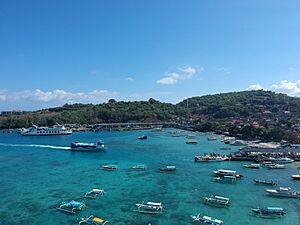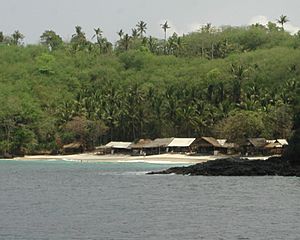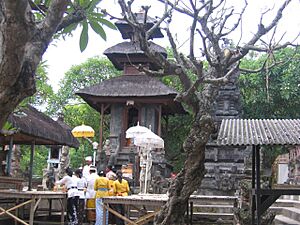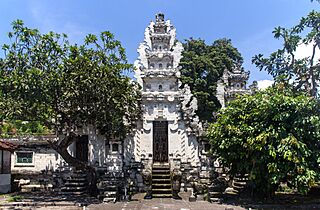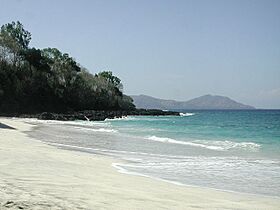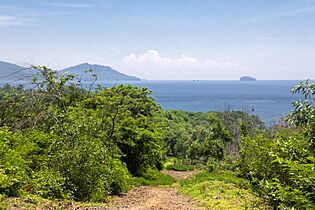Padangbai facts for kids
Quick facts for kids
Padangbai
|
|
|---|---|
| Country | Indonesia |
| Province | Bali |
| Time zone | UTC+8 (Central Indonesia Time) |
Padangbai is a small town on the coast in south-eastern Bali, Indonesia. It's a busy ferry port. From here, you can travel by ferry to places like Lembar on Lombok, the famous Gili Islands, and other islands nearby.
Contents
Discover Padangbai's Location
Padangbai is located in the Manggis District. It's found off the main road that runs along Bali's south-east coast.
It is about 56 kilometers (35 miles) north-east of Denpasar Airport. This drive usually takes about 1 hour and 20 minutes. Padangbai is also 44 km (27 miles) north-east of Sanur Beach. It's about 37 km (23 miles) east of Ubud. The town is 13 km (8 miles) west of Candidasa. It is also 18 km (11 miles) east of Semarapura.
Explore Notable Places in Padangbai
Beaches and Diving Spots
Padangbai has four beaches and many great places to go diving. The Blue Lagoon sites are very special. They became part of a Marine Protected Area in 2017. Bias Tugal Beach is also part of this protected area.
It's important to know about the ocean currents here. They can get strong when the tide changes. They are also strong during the new moon.
Many diving companies use Padangbai as their base. This is because there isn't a good place for dive boats in Candidasa. So, divers come to Padangbai to start their underwater adventures.
Main Beach
This long, narrow beach is just east of the port. The main street, Jl. Silayukti, runs along it.
Diving: The Ferry Channel dive site is close to the green light. This light marks the side of the narrow channel used by ferries. This site has several flat areas. It also has some overhangs. These create small hiding spots for many different sea creatures. This dive site goes down to 30 meters (98 feet) or more.
Blue Lagoon Beach
This beach is also called Padang Kurungan. It's a popular spot for visitors.
Diving: There are six different dive sites here. They are good for everyone, from beginners to expert divers. The currents are usually mild to moderate. The shallow coral reef goes down to 25 meters (82 feet). It has a gentle slope and a short wall. You can often see clearly for about 25 meters (82 feet) or more.
Here are some of the dive sites:
- The Temple site is shallow, about 5 to 9 meters (16 to 30 feet deep). It's in front of a small temple built into the lava cliffs. This spot is quite protected from strong currents.
- The Tanjung Sari site is at the southern end of the Blue Lagoon. It stretches along the cape that separates the Blue Lagoon from the harbor. It has volcanic rock formations. The reef slopes down to about 30 meters (98 feet).
- The Drop Off site is where the Blue Lagoon meets Amuk Bay. It's a rocky cape that continues underwater as a vertical wall. This wall goes down to 30 meters (98 feet).
- The Jepun or Tanjun Jepun site is on the west coast of Amuk Bay. It has an artificial reef. There's a small shipwreck here, sunk on purpose in 2008. It sits at 18 meters (59 feet) deep. You can also see some Buddha statues.
Bias Tugal Beach
This beach is also known as Pantai Kecil, Little Beach, or White Sand Beach. It's near the market. You need to take a 1.4 km (0.87 mile) road to get there. The beach is about 130 meters (426 feet) long. Its name means 'Separated Sand'. This is because it's where the black volcanic sand beaches change to pure white sand.
Diving: The whole bay has a flat bottom, about 9 meters (30 feet) deep. It's covered with soft coral. There are also several large rocks with hard coral. About 50 meters (164 feet) from the beach, the seafloor slopes down at a 45-degree angle. There's a flat ledge at 20 meters (66 feet) deep.
Black Sand Beach
This beach is also called Mimba Beach or Kusamba Beach. It's known for its traditional salt mining.
Ancient Temples
Padangbai is home to several important temples. These temples are special places for prayer and history.
- Pura Silayukti (or Luhur Silayukti) is on a small piece of land east of town. It's the most important historical site in Padangbai. It dates back to the 11th century. A Javanese priest named Empu Kuturan is said to have lived here. He brought the caste system to Bali in the 11th century. The temple's name means "true basis" or "upholding true teachings."
- Pura Telaga Mas is just north of Silayukti temple.
- Pura Tanjung Sari is just south of Silayukti temple.
- Pura Tirta Segara Muncar is at the end of the peninsula where Silayukti temple sits. It's close to sea level. Tirta means it's a water temple.
- Pura Dalem is in town, north of the harbor.
- Pura Pesamuhan is at the west end of Jl Silayukti.
- Pura Penataran Agung is west of the harbor. It is believed to have been built in the 16th century. The high priest Dang Hyang Nirartha built it during his travels in Bali.
- Pura Mumbul is south of the harbor.
- Pura Puseh is north-west of town.
Traditional Salt Mining
In Kusamba, a village near Padangbai, people traditionally harvest salt. They do this right on the black sand beach. This area is close to the Goa Lawah temple.
First, they make a salty water mixture. They collect seawater in buckets. Then, they slowly pour it into wooden basins filled with black sand from the beach. The water that comes out is collected. They repeat this process a few times.
Next, the salty water rests in special vats made of coconut tree wood. It stays there for a few days or even a couple of weeks. Some of the water evaporates during this time. Later, the water is moved to hollowed-out coconut trunks. The sun helps the rest of the water evaporate. What's left is the salt, which is carefully scraped out.
This hard work creates a unique salt. It has a special flavor. This Balinese salt is becoming more famous. Good restaurants in Bali are starting to use it. You can also buy it in shops around Bali. This renewed interest might help save this traditional way of making salt. It has been difficult for them to compete with cheaper, factory-made salt.
About 10 to 12 tons of Kusamba sea salt are made each month during the dry season. This salt is rich in minerals and iodine. There is a natural salt market in Kusamba where you can find it.
Coral Reef Restoration Efforts
Livingseas is an organization working east of Padangbai. They are just north of the Blue Lagoon Beach. Their goal is to build a 5-hectare (12.3-acre) coral reef.
They started this project in 2019. They use special steel structures shaped like hexagons. These structures are covered with resin and sand. They are placed close together on the seabed. This helps corals grow faster and more densely. It takes about two years for the structures to be completely covered by growing corals.
Livingseas also teaches local young people about marine life. They also help clean up trash from the ocean. As of 2024, they have brought back to life 2,719 square meters (about 29,267 square feet) of the seabed.
Gallery
-
Some interesting Street art found in Padangbai.



